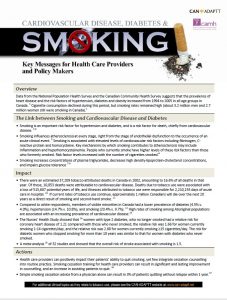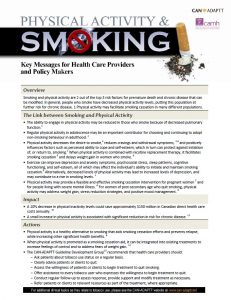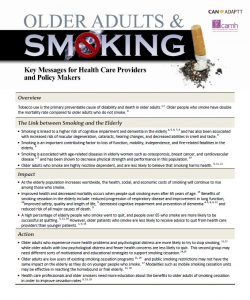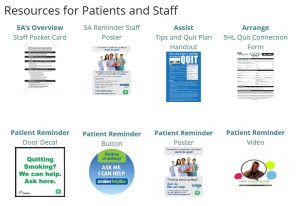PRIMARY CARE
Impact of interventions on tobacco use morbidity and mortality
Primary care practitioners are ideally suited to provide integrated tobacco cessation interventions at multiple points in time and with a variety of patient populations as part of regular care throughout a tobacco users’ quit journey. Tobacco cessation interventions delivered by multiple health care providers across various disciplines has been shown to increase quit rates. In Ontario, 81.3% of people had a consultation with a family doctor/general practitioner or a nurse which is an opportunity for them to receive advice about quitting smoking.
Evidence to support tobacco dependence interventions
- Strategies to increase the delivery of smoking cessation treatments in primary care settings: A systematic review and meta-analysis.: Journal Article
- Integrating Smoking Cessation into Daily Nursing Practice: Registered Nurses Association of Ontario
- Canadian Smoking Cessation Best Practice Guideline: Best Practice Guideline
Examples of evidence-based practice systems
Examples of patient assessment and pharmacotherapy tools
- Free stop smoking medications are available in Ontario.
- The Centre for Addiction and Mental Health – Algorithm for tailoring pharmacotherapy in primary care settings
Resources for staff and clients
Resources Tailored for Primary Care Patients and Staff:
| Cardiovascular Disease, Diabetes & Smoking Fact Sheet  |
Physical Activity & Smoking Fact Sheet  |
Older Adults & Smoking Fact Sheet  |
Additional Resources for all health care settings  |
Available for download. Contact your local Public Health Unit or Smokers’ Helpline for requests to adapt resources.
Training opportunities for primary care staff
Healthcare providers are considered a credible source of information by patients – you can help your patients to quit smoking, even with just a few minutes of your time.
- Training opportunities are available for both brief interventions with clients (1-3 minutes), as well more intensive interventions (10+ minutes)
- University of Ottawa Heart Institute – Ottawa Model for Smoking Cessation: E-Learning & Workshops
- Registered Nurses Association of Ontario (RNAO) Tobacco-Free RNAO is a comprehensive initiative designed to support nurses and other health care providers to implement the RNAO’s best practice guideline (BPG) for smoking cessation “Integrating Smoking Cessation into Daily Nursing Practice.”
Monitoring and evaluation
An integral part of implementing a tobacco cessation system of practice is to ensure that all patients are asked about tobacco use and offered information and support to quit.
- Ontario Tobacco Research Unit (August 2013). Data Standards for Smoke-free Ontario Smoking Cessation Service Providers
- Common measures and definitions are provided to ensure equivalent reporting by service providers.
- Key data standards and definitions are provided for adult (18 years of age and older) tobacco users participating in smoking cessation programs.
- Utilize these data standards/questions and definitions when creating your patient assessment forms.
- Registered Nurses Association of Ontario Best Practice Guideline for Smoking Cessation– Smoking Cessation Evaluation Tool
- Templates, chart audit questions, in-clinic questions, post discharge follow-up interview questions
- University of Ottawa Heart Institute – Primary Care
- 53 primary-care organizations, representing more than 150 primary-care sites used the Ottawa Model since
- 14,513 patients were advised to quit smoking by Family Health Teams.
- 4,544 patients expressing an interest in quitting smoking were referred to quit plan visits with trained cessation counselors.
- 2,233 of these patients being referred to a telephone/email follow-up program (OTRU, 2014).
- 53 primary-care organizations, representing more than 150 primary-care sites used the Ottawa Model since
- Physician Billing Code Data
Primary care practices can track and monitor the use of the initial and follow-up cessation counselling billing codes by participating physicians.- Use search or flag functions within the Electronic Medical Record system.
For example, in Ontario (2006-2010) data collected on the use of the MOHLTC physician billing codes for smoking cessation found:
- 611,690 patients in Ontario received an initial cessation counselling session from a physician.
- 218,366 was the largest number of patients served in 2008 may be attributable to the expansion of the eligibility criteria for billing to all primary care physicians in that year.
- 114,160 patients received one or more follow-up counselling sessions.
- The number of individuals receiving these sessions has increased over time; it represents only a small proportion of the initial counselling recipients (9% to 22%).
- Le Foll, B. & George, T.P., 2007
- Agency for Healthcare Research and Quality, 2008
- Canadian Community Health Survey (Cycle 5.1: 2009-2010), Statistics Canada, Share File, Ontario MOHLTC, extracted July 16, 2014.
